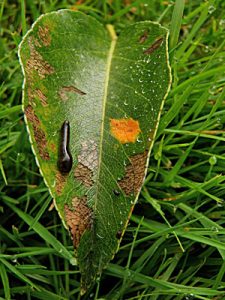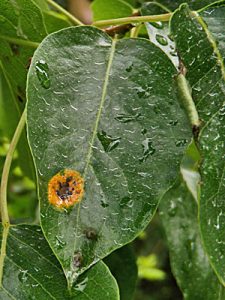This is a fairly recent disease in Whatcom and Skagit counties, but recently has been showing up with increasing frequency. Because of the accelerated spring, the spots are showing up earlier than usual this year.
As with most rust diseases, this one has two host plants, fruiting pear trees and juniper (Juniperus sp.). Both must be present for the disease to complete its life cycle. If this disease shows up in your orchard, you should first remove junipers within 100 feet of your pear trees. I know this is not always an option, especially if you live on a city lot, and the junipers are not on your property.
- Early stages of pear trellis rust (plus pear slug, a sawfly larvae that will chew on pear leaves).
- Later stages of trellis rust.
The first signs on pear are bright orange spots on the leaves most years in late May (this year in late April). The spots enlarge during the summer reaching a diameter of one to two cm. By late June, the centers of the spots (on the upper leaf surface) exhibit numerous black dots. In July and early August, the infected area of the leaf becomes thickened as spore-producing structures push out from the lower surface. From late August through to leaf drop in October or November, grey hair-like projections resembling trellises emerge from the lower surface and release spores. These spores are capable of infecting junipers.
The only time that infections are obvious on junipers is during wet weather in April and early May. At that time, swellings on the juniper branches release an orange jelly-like mass of spores. These spores are capable of
infecting nearby pear leaves which are just starting to grow. After the spores are released, the infection on juniper remains dormant until the next spring.
Steps you can take:
- Remove junipers within 100 feet of your pear trees (some sources say 1000 feet!) Juniperus communis, Juniperus horizontalis, and Juniperus squamata are resistant.
- Hand pick leaves with rust as soon as you see them, and dispose of them (not in the compost!)
- Apply copper at leaf drop in the fall and again as pears break dormancy in spring.
- As a last resort, use a fungicide labelled to treat rust, such as Serenade, when you see the spots appear in early summer.




Will just removing the spots be sufficient to stop the release of spores? I’ve been using a single hole-punch to punch out the rust and leave the rest of the leaf on the tree. Otherwise I’ll have to nearly defoliate my pear, which I did last year and I’m reluctant to do it 2 years in a row.
If I must remove each infected leaf, (>90% are infected), with application of extra water and nutrition would the tree put out a few new leaves?
Young tree, hasn’t fruited yet.
If you can keep the ‘trellis’ from forming, spores will not be released.